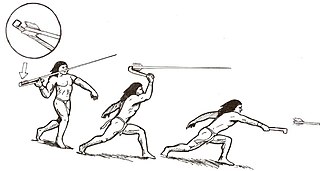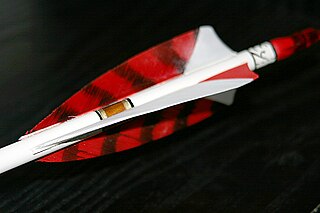
Archery is the sport, practice, or skill of using a bow to shoot arrows. The word comes from the Latin arcus, meaning bow. Historically, archery has been used for hunting and combat. In modern times, it is mainly a competitive sport and recreational activity. A person who practices archery is typically called an archer, bowman, or toxophilite.
A bolt or quarrel is a dart-like projectile used by crossbows. The name "quarrel" is derived from the French word carré, meaning square, referring to their typically square heads. Although their lengths vary, bolts are typically shorter and heavier than traditional arrows shot with longbows.

An arrow is a fin-stabilized projectile launched by a bow. A typical arrow usually consists of a long, stiff, straight shaft with a weighty arrowhead attached to the front end, multiple fin-like stabilizers called fletchings mounted near the rear, and a slot at the rear end called a nock for engaging the bowstring. A container or bag carrying additional arrows for convenient reloading is called a quiver.

In archaeological terminology, a projectile point is an object that was hafted to a weapon that was capable of being thrown or projected, such as a javelin, dart, or arrow. They are thus different from weapons presumed to have been kept in the hand, such as knives, spears, axes, hammers, and maces.

A spear-thrower, spear-throwing lever, or atlatl is a tool that uses leverage to achieve greater velocity in dart or javelin-throwing, and includes a bearing surface which allows the user to store energy during the throw.

Ballistics is the field of mechanics concerned with the launching, flight behaviour and impact effects of projectiles, especially ranged weapon munitions such as bullets, unguided bombs, rockets or the like; the science or art of designing and accelerating projectiles so as to achieve a desired performance.

The bow and arrow is a ranged weapon system consisting of an elastic launching device (bow) and long-shafted projectiles (arrows). Humans used bows and arrows for hunting and aggression long before recorded history, and the practice was common to many prehistoric cultures. They were important weapons of war from ancient history until the early modern period, where they were rendered increasingly obsolete by the development of the more powerful and accurate firearms. Today, bows and arrows are mostly used for hunting and sports.

An arrowhead or point is the usually sharpened and hardened tip of an arrow, which contributes a majority of the projectile mass and is responsible for impacting and penetrating a target, as well as to fulfill some special purposes such as signaling.
A Swiss arrow is a type of enlarged dart in the shape of an arrow that is thrown with the aid of a lanyard, which is retained by a small notch close to the fletching. It is very similar to an amentum and uses the same throwing principle as a spear-thrower.

Fletching is the fin-shaped aerodynamic stabilization device attached on arrows, bolts, darts, or javelins, and are typically made from light semi-flexible materials such as feathers or bark. Each piece of such fin is a fletch, also known as a flight or feather. A fletcher is a person who attaches fletchings to the shaft of arrows.

A ranged weapon is any weapon that can engage targets beyond hand-to-hand distance, i.e. at distances greater than the physical reach of the user holding the weapon itself. The act of using such a weapon is also known as shooting. It is sometimes also called projectile weapon or missile weapon because it typically works by launching solid projectiles ("missiles"), though technically a fluid-projector and a directed-energy weapon are also ranged weapons. In contrast, a weapon intended to be used in hand-to-hand combat is called a melee weapon.
Plumbatae or martiobarbuli were lead-weighted darts carried by infantrymen in Antiquity and the Middle Ages.

The throwing stick or throwing club is a wooden rod with either a pointed tip or a spearhead attached to one end, intended for use as a weapon. A throwing stick can be either straight or roughly boomerang-shaped, and is much shorter than the javelin. It became obsolete as slings and bows became more prevalent, except on the Australian continent, where the native people continued refining the basic design. Throwing sticks shaped like returning boomerangs are designed to fly straight to a target at long ranges, their surfaces acting as airfoils. When tuned correctly they do not exhibit curved flight, but rather they fly on an extended straight flight path. Straight flight ranges greater than 100 m (330 ft) have been reported by historical sources as well as in recent research.

An amentum was a leather strap attached to a javelin used in ancient Greek athletics, hunting, and warfare, which helped to increase the range and the stability of the javelin in flight. Stability in flight was important because it allowed the javelin to land on its point, which was the only way the throw could be accurately recorded in competition or be useful against a live target. An amentum also increased the effective length of the throwing arm, as does a spear-thrower, and so enhanced speed.
Hunting weapons are weapons designed or used primarily for hunting game animals for food or sport, as distinct from defensive weapons or weapons used primarily in warfare.

A javelin is a light spear designed primarily to be thrown, historically as a ranged weapon. Today, the javelin is predominantly used for sporting purposes such as the Javelin throw. The javelin is nearly always thrown by hand, unlike the sling, bow, and crossbow, which launch projectiles with the aid of a hand-held mechanism. However, devices do exist to assist the javelin thrower in achieving greater distances, such as spear-throwers or the amentum.
This is a list of archery terms, including both the equipment and the practice. A brief description for each word or phrase is also included.

Native American weaponry was used by Native American warriors to hunt and to do battle with other Native American tribes and European colonizers.

Throwing is an action which consists in accelerating a projectile and then releasing it so that it follows a ballistic trajectory, usually with the aim of impacting a remote target. This action is best characterized for animals with prehensile limbs: in this case the projectile is grasped, while the limb segments impart a motion of the hand through compounded mechanical advantage. For other animals, the definition of throwing is somewhat unclear, as other actions such as spitting or spraying may or may not be included.




















